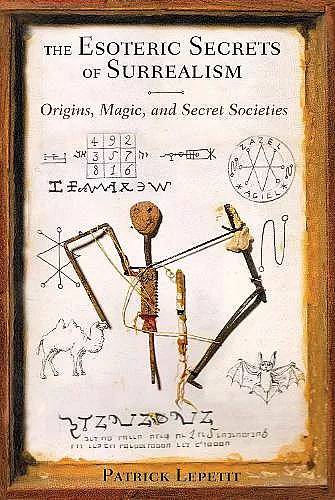The Esoteric Secrets of Surrealism
Origins, Magic, and Secret Societies
Format:Paperback
Publisher:Inner Traditions Bear and Company
Published:22nd May '14
Currently unavailable, our supplier has not provided us a restock date
This paperback is available in other editions too:
- Paperback£23.00(9780892811991)
- Paperback£21.00(9781594773365)
- Set / collection£18.99(9781922573247)

Not merely an artistic or literary movement as many believe, the surrealists rejected the labels of artist and author bestowed upon them by outsiders, accepting instead the titles of magician, alchemist, or--in the case of Leonora Carrington and Remedios Varo--witch. Their paintings, poems, and other works were created to seek out unexplored regions of the mind and recover lost "psychic" and magical powers. They used creative expression as the vehicle to attain what André Breton called the "supreme point," the point at which all opposites cease to be perceived as contradictions. This supreme point is found at the heart of all esoteric doctrines, including the Great Work of alchemy, and enables communication with higher states of being. Drawing on an extensive range of writings by the surrealists and those in their circle of influence, Patrick Lepetit shows how the surrealists employed mythology, gnostic principles, tarot, voodoo, and alchemy not simply as reference points but as significant elements of their ongoing investigations into the fundamental nature of consciousness. He provides many specific examples of esoteric influence among the surrealists, such as how Picasso's famous Demoiselles d'Avignonwas originally titled The Bath of the Philosophers, how painter Victor Brauner drew from his father's spiritualist vocation as well as the Kabbalah and tarot, and how doctor and surrealist author Pierre Mabille was a Freemason focused on finding initiatory paths where "it is possible to feel a new system connecting man with the universe." Lepetit casts new light on the connection between key figures of the movement and the circle of adepts gathered around Fulcanelli. He also explores the relationship between surrealists and Freemasonry, Martinists, and the Elect Cohen as well as the Grail mythos and the Arthurian brotherhood.
“This book is a necessary resource for those readers interested, or rather compelled, by the implicit and explicit relationships between surrealism and the initiatory forms that comprise the great traditions of the esoteric and occult arts. The author, whose enthusiasm for his subject is equaled by his erudition, provides for the first time in English translation numerous excerpts from noted surrealists commenting directly on the subject at hand, whether it be divination, astrology, dark romanticism, the Celtic world, or alchemy, magic, Voudoun, Gnosticism and mythopoesis. His exegesis and conclusions are ripe, and should provoke the reader not only in terms of encountering the texts and works discussed throughout the various ages and contexts they were created in but also in recollecting, or revisiting, quite personal moments that have acted as levers or axial junctures from which much else evolved. Patrick Lepetit’s scholarship in this regard is revivifying and precise. A much needed looking glass into a still evolving gyre in which science, as a capacity for astute observation, and poetry, where our internal and external theaters merge, have ever the potential of reaching new syntheses.” * Allan Graubard, co-author of Invisible Heads: Surrealists in North America - An Untold Story and aut *
“Lepetit’s book remains an excellent one. For readers with an interest in occultism and spirituality it offers a journey of initiation into the arcana of modern art and literature; for scholars and students of the surrealist movement, it is essential reading. According to the English-born surrealist Leonora Carrington, modern men should abandon themselves to the great ocean of the unknown and rediscover a sense of magic and enchantment amid the dull and monotonous shades of rationalized society. Reading Lepetit's study is a first plunge into precisely this sea of spirituality.” * Art Papers, Daniel Zamani, September 2014 *
“French scholar Lepetit’s first English-language book, translated by Jon E. Graham, draws extensively on the work of others to suggest links between esoteric traditions and the surrealist movement. Lepetit calls on a parade of commentators to support his argument that surrealist artists such as André Breton and his colleagues were more than avant-garde painters and poets. Instead, posits Lepetit, they had strong ties to spiritualists, Freemasons, voodoo practitioners, and secret societies of all stripes; he believes that their message was not only psychological, but essentially spiritual. Lepetit is an enthusiastic researcher, and this volume is thick with quotations, references, and footnotes that explore every aspect of surrealism. Precisely how all of these dimensions are related to each other is not always clear, because quotations so rapidly follow one another that they leave little room for Lepetit to comment or readers to reflect. While textual sources abound, Lepetit includes only 21 illustrations to provide examples of the wealth of surrealist art he refers to in the text. Previous knowledge of surrealist art and the history of the occult are recommended before delving into Lepetit’s specialized body of knowledge. A comprehensive bibliography provides ample opportunity for additional exploration.” * Publishers Weekly, February 2014 *
ISBN: 9781620551752
Dimensions: 229mm x 152mm x 33mm
Weight: 713g
544 pages